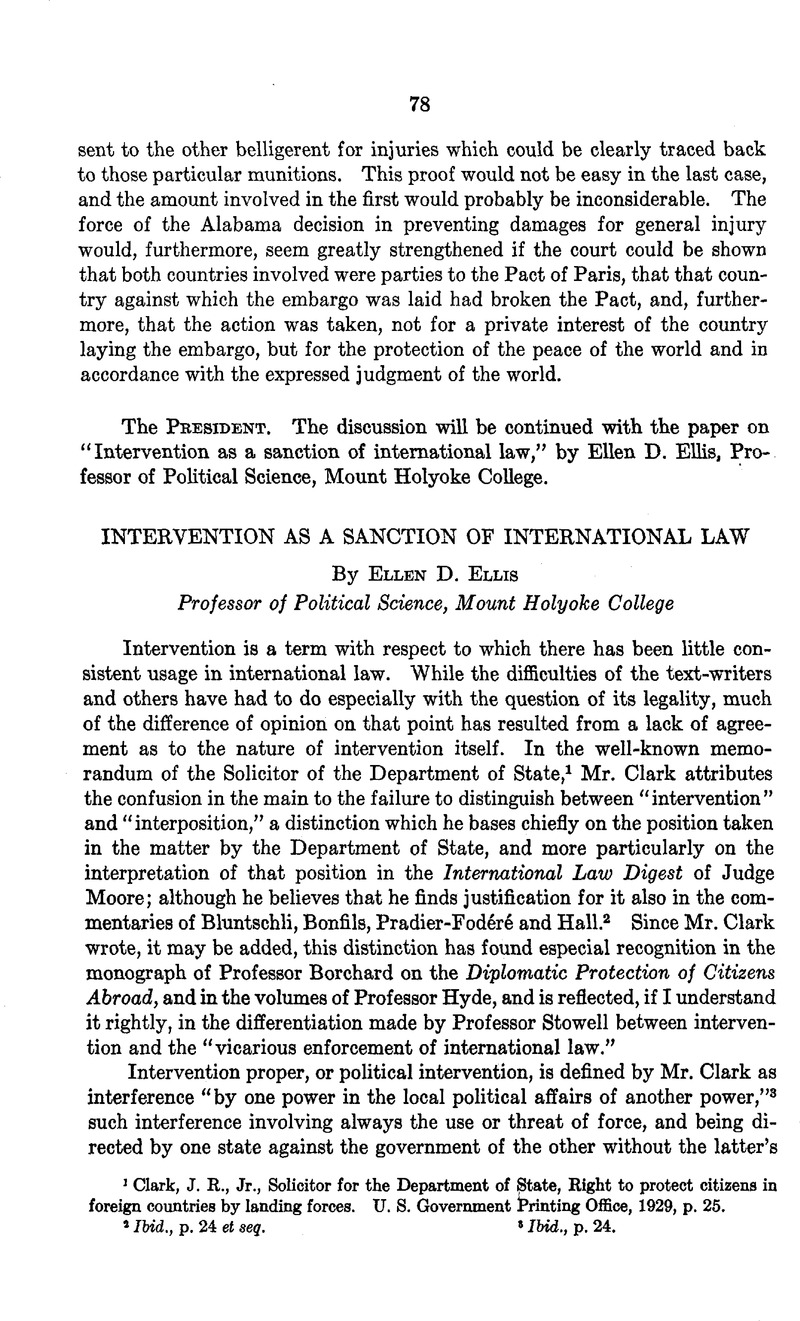No CrossRef data available.
Article contents
Intervention as a Sanction of International Law
Published online by Cambridge University Press: 27 February 2017
Abstract

- Type
- Second Session
- Information
- Copyright
- Copyright © American Society of International Law 1933
References
1 Clark, J. R. Jr., Solicitor for the Department of State, Right to protect citizens in foreign countries by landing forces. U. S. Government i’rinting Office, 1929, p. 25 Google Scholar.
2 Ibid., p. 24 et seq.
3 Ibid., p. 24.
4 Clark, J. R., Jr., op. cit., p. 25.
5 Borchard, E. M., The Diplomatic Protection of Citizens Abroad, New York, 1928, p. 442 Google Scholar.
6 “While such action,” writes Mr. Borchard, referring to interposition, “has generally been necessary under the circumstances, and while it cannot be considered political intervention, it is nevertheless an impeachment of the effective sovereignty of the country occupied.” Ibid., p. 449. See also address of Mr.Root, , American Journal of International Law, Vol. 4 (1910), pp. 520–521 CrossRefGoogle Scholar.
7 Lingelbach, W. E., “The Doctrine and Practice of Intervention in Europe,” Annals of the American Academy of Political and Social Science, Vol. XVI, 1900, p. 26 Google Scholar. “By Sanction is meant both the penalty and the power necessary to enforce. The three essential elements being the rule, the obligation and the sanction,” also p. 26.
8 Oppenheim, L., International Law, Vol. 1, London, 1912, p. 13 Google Scholar.
9 Lawrence, T. J., The Principles of International Law, 7th ed., Boston, 1923, p. 121.Google Scholar
10 Oppenheim, op. cit., I, p. 195.
11 Fauchille, Paul, Train de droit international public, Paris, 1921-1926, I, p. 539 et seq Google Scholar.
12 Oppenheim, op. cit., I, p. 189.
13 Cf. Hall, W. E., International Law, 8th ed., Oxford University Press, 1924, p. 65.Google Scholar
14 Eagleton, Clyde, International Government, New York, 1932, p. 71.Google Scholar
15 Dickinson, E. D., The Equality of States in International Law, Harvard University Press, 1920, p. 305 Google Scholar.
16 Ibid., pp. 292, 293.
17 Development of the League of Nations Idea. Documents and Correspondence of Theodore Marburg. Edited by Latane, John H., 2 vols., New York, 1932 Google Scholar.
18 Miller, David Hunter, The Drafting of the Covenant, 2 vols., New York, 1928. I, p. 180 Google Scholar.
19 Cf. Bonfila-Fauchille, op. cit., I, p. 663, and Oppenheim, op. cit., I, p. 269.
20 Ray, Jean, Commentaire du Pacte de la Societe des Nations, Paris, 1930, p. 346 Google Scholar.
21 Cf. ibid., p. 388 et seq; and Redslob, Robert, Theorie de la Societe des Nations, Paris, 1927, p. 54 Google Scholar.
22 Minutes, Sixth Committee, First Assembly, pp. 261–263, 337; Plenary Meetings, First Assembly, pp. 408–409; Minutes, First Committee, Fourth Assembly, pp. 11–18, 24–28; Plenary Meetings, Fourth Assembly, pp. 75–87.
23 Ibid.
24 Cf. Oppenheim, op. cit., Vol. II, London, 1926, pp. 63 and 256; and Memorandum on Articles 10, 11 and 16 of the Covenant, submitted by M. Rutgers, Rapporteur, C. A. S. 10.4.
25 Cf. Hudson, M. O., The Verdict of the League, World Peace Foundation, Boston, 1933, P. 84 Google Scholar.
26 Cf. Conwell-Evans, T. P., The League Council in Action, Oxford University Press, 1929, p. 36 Google Scholar.


